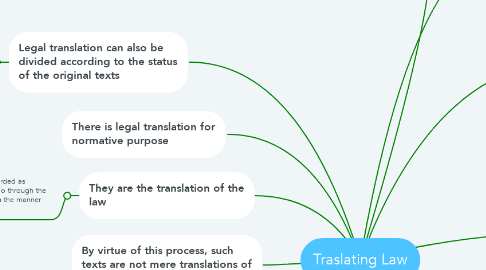Traslating Law
by Paula Andrea Reina Obando

1. Legal style refers to the linguistic aspects of the written legal language and also the way in which legal problems are approached, managed and solved.
2. Characterisation of legal language
2.1. Is a general description of the linguistic markers believed to be common in most if not all legal languages in varying degrees
3. It is a type of the translational activity involving special language use, that is, language for special purpose (LSP) in the context of law, or language for legal purpose (LLP)
3.1. Comparative analysis of the two major legal systems: The Common Law and the Civil Law
3.2. Classification of general, specialist and literary translation
3.3. Legal translation falls under the specialist category, or technical translation
4. Pragmatics
4.1. Depends upon the performative nature of language.
4.2. Perform acts, creating facts, rights and institutions.
4.3. Another pragmatic consideration in legal texts is ambiguity, vagueness and other uncertainties.
5. Style
5.1. Generally characterised by an impersonal style, declarative sentences pronouncing rights and obligations.
6. Legal translation can also be divided according to the status of the original texts
6.1. Translating enforceable law, e.g. statutes
6.2. Translating non enforceable law, e.g. legal scholarly works
7. There is legal translation for normative purpose
8. They are the translation of the law
8.1. Such legal texts are regarded as authoritative once they go through the authentication process in the manner prescribed by law
9. By virtue of this process, such texts are not mere translations of law, but the law itself.
10. Lexicon
10.1. Is a distinctive feature of legal language being the complex and unique legal vocabulary found in different legal languages
10.2. Different legal languages have their own unique legal vocabulary
11. Syntax
11.1. Is the formal and impersonal written style coupled with considerable complexity and length.
11.2. Extensive use of conditions, qualifications and exceptions.
11.3. Apart from long and complex sentence structures found in most legal languages, there are also syntactical peculiarities to each legal language.
12. Legal translation has the characteristics of technical translation and also shares some of the features of general translation
13. Legal translation has been classified according to the subject matter of the SL texts into the following categories
13.1. Translating domestic statutes and international treaties
13.2. Translating private legal documents
13.3. Tanslating legal scholarly works
13.4. Translating case law
14. Legal texts
14.1. Legislative texts: * Domestic statutes * Subordinate laws * International treaties * Multilingual laws, and other laws.
14.2. Legal scholarly texts produced by academic lawyers or legal scholars in scholarly works and commentaries
14.3. Judicial texts produced in the judicial process by judicial officers and other legal authorities
14.4. Private legal texts that include texts written by lawyers, e.g. contracts, leases, wills and litigation documents, and also texts written by non-lawyers


